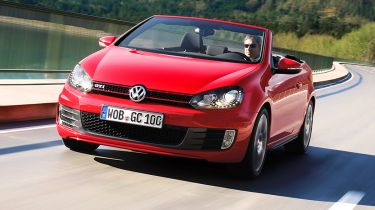VW Golf GTI Cabriolet
We get behind the wheel of the new Volkswagen Golf GTI Cabriolet ahead of first deliveries in July
The VW Golf GTI Cabriolet blends two talented cars – the GTI hatch and the Golf Cabriolet – with predictably excellent results. The roof is properly integrated, offering comfort and refinement when it’s up, and a sophisticated look when it’s down. It also offers plenty of power, great dynamics and surprising practicality, but commands a significant premium over the hatch.
The Volkswagen Golf GTI Cabriolet is the first soft-top to wear the GTI badge since the legendary MkI, so it has some big shoes to fill. It brings together the GTI hatchback’s mechanicals with the Golf Cabriolet body to create a rival for the MINI JCW Cabriolet.
From the outside, it’s instantly recognisable as a GTI. It gets the standard polished 18-inch alloys, lowered suspension and a black honeycomb grille with red horizontal highlights. The chrome strip around the waistline looks great, too.
The fabric roof feels sturdy but doesn’t quite follow the hatch’s roofline when it’s raised. Drop it, and it looks far sportier. A permanent compartment for the roof to fold into means there’s no fiddly boot separator, and with it up there’s only a fraction more wind noise than the hatch at motorway speeds.
The electro-hydraulic roof takes 11.5 seconds to close and 9.5 seconds to open, exposing the traditional GTI cabin. There’s the same high-quality interior with classic tartan cloth trim (leather is an option) and a sporty flat-bottom steering wheel.
Used - available now

2021 Land Rover
Range Rover
27,750 milesAutomaticDiesel3.0L
Cash £49,995
2022 BMW
3 Series Touring
52,456 milesAutomaticDiesel2.0L
Cash £23,800
2018 Mazda
6 Saloon
48,985 milesAutomaticPetrol2.0L
Cash £12,600
2023 Mercedes
EQC
55,207 milesAutomaticElectric
Cash £22,300On the road, slicing off the roof hasn’t diminished the GTI’s abilities too badly. The 207bhp 2.0-litre turbocharged engine remains unchanged from the hatch, so it has the same docile, easy-to-drive nature around town and eagerness to rev when the road opens up.
A weight gain of 138kg marginally slows the soft-top’s 0-62mph time, down 0.4 seconds to 7.3 seconds. Above 2,500rpm, dropping the top is the best way to enjoy the turbo whistle and the burble from the exhaust – a sensory overload you can’t get with the hatch.
Scuttle shake is there, but minimal, and, as with the sister car, the suspension is firm. Yet the cabrio feels extremely well planted and turns in precisely when you’re attacking corners. The standard electronic differential, which gently brakes the wheel with the least grip, works brilliantly – slinging you out of bends and helping to deploy more of the power more of the time.
Being a convertible, it’s only available as a three door, but there’s still 250 litres of boot space with the roof up or down. That means it’s not as practical as the hatch, but it’s far more useable than a MINI Cabriolet or a Mazda MX-5 even as an everyday runaround. It returns 37.2mpg and emits 177g/km of CO2, compared to the hatch’s 39mpg and 170g/km).
There are downsides carried over from the hatch: it's a little softer in its ride, and, for real driving enthusiasts, you should be able to turn the ESP off completely.
Some VW traditionalists might have winced at the idea of a GTI Cabriolet, but this car stays true to the legendary badge. Just like the hatchback, it offers refinement when you need it engaging dynamics on the right road. The fact that you can take its roof down adds another string to its bow.







